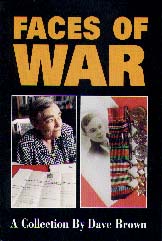|
________________
CM . . . .
Volume VI Number 6 . . . . November 12, 1999
Faces of War comprises a collection of newspaper columns written under the rubric of "Brown's
Beat" in the Ottawa Citizen during the last half decade. The ambit of the book includes both world
wars, though it does not attempt to present any systematic history of those two conflicts. Nor is a
detailed familiarity with that history necessary to an appreciation of the collection. Those two wars
are the occasion for the vignettes; the focus is war itself and the experience of ordinary people living
through it. Brown claims no personal war experience, but, from early childhood, he had a fascination
with the stories of those around him and an obvious capacity to draw those stories out. A media
award presented to him by the Royal Canadian Legion evidences the fairness and accuracy of the
portraits he is able to draw in these short articles. That same concern for accuracy and detail brought
him not just into the homes and confidence of his subjects, but also to the battlefields of Europe
where their stories had taken place. His empathy for their experience is seen as well in the imaginary
"interviews" he conducts with those who did not return, but remained in one of the cemeteries or
mass graves of the Western Front. Some of his subjects are famous; but, for the most part, they are
part of the large mass unknown except to family and friends. Brown's ultimate "truth" about wars
is that they are fought by boys, although his cast involves other than fighting men and prisoners of
war. Included as well is a battlefield nurse, the Merchant Marine, chaplains and war correspondents.
Recommended.
Alexander D. Gregor is the Director of the Centre for Higher Education Research and Development
at the University of Manitoba.
To comment on this title or this review, send mail to cm@umanitoba.ca.
Copyright © the Manitoba Library Association.
Reproduction for personal use is permitted only if this copyright notice
is maintained. Any other reproduction is prohibited without
permission.
Published by
TABLE OF CONTENTS FOR THIS ISSUE - November 12, 1999.
AUTHORS |
TITLES |
MEDIA REVIEWS |
PROFILES |
BACK ISSUES |
SEARCH |
CMARCHIVE |
HOME
|
